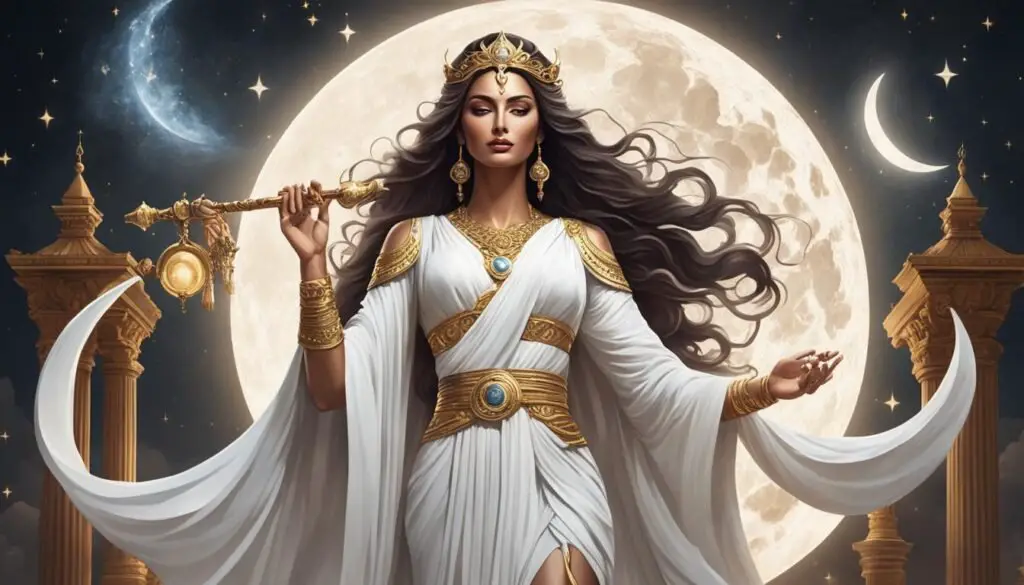In Greek mythology, the moon goddess holds a significant place among the divine figures. One of the most renowned and captivating moon goddesses is Selene, also known as Mene. She personifies the moon itself and embodies the beauty and mystique associated with it.
Selene is the daughter of the Titans Hyperion and Theia, and the sister of the sun god Helios and the dawn goddess Eos. Her divine lineage and family connections hold symbolic significance in her role as the moon goddess.
Often depicted driving her moon chariot across the heavens, Selene illuminates the night sky and enchants mortals with her radiant presence. She is associated with various lovers, including Zeus, Pan, and the mortal Endymion, adding depth to her character and stories.
In post-classical times, Selene became linked with Artemis, and both goddesses were associated with the powerful goddess Hecate. Selene’s connections with other gods and figures in Greek mythology contribute to her complexity and importance in the pantheon.
Throughout Greek history, Selene has been represented in various forms of art. Her iconic portrayal includes riding a horse or driving a chariot pulled by white horses, emphasizing her ethereal nature. Symbols like the crescent moon and crown are associated with Selene, representing her connection to lunar cycles and her divinity.
Worship of Selene involved rituals and festivals that honored her as the goddess of the moon. These practices took place during significant lunar phases, such as the Full Moon and New Moon, and incorporated moon-watching, offerings, and prayers.
Overall, Selene’s significance in Greek mythology lies in her role as the goddess of the moon, her relationships with other deities and mortals, and her connection to nature and the cycle of life.
Key Takeaways:
- Selene is the Greek goddess and personification of the moon in Greek mythology.
- She is the daughter of Hyperion and Theia, and sister to Helios and Eos.
- Selene is associated with various lovers, including Zeus and the mortal Endymion.
- Her artistic representations often feature her driving a moon chariot pulled by white horses.
- Worship of Selene involved rituals and festivals during significant lunar phases.
Selene – The Greek Goddess of the Moon
Selene is revered as the divine embodiment of the moon in Greek mythology. As the daughter of Hyperion and Theia, she was part of the younger generation of Titans who played a significant role in Greek pantheon.
Selene’s role as the goddess of the moon includes illuminating the night sky and enchanting mortals with her radiance. She is associated with her brother Helios, the sun god, and her sister Eos, the goddess of the dawn.
- Selene is the divine embodiment of the moon in Greek mythology.
- She is the daughter of Hyperion and Theia.
- Selene illuminates the night sky and enchants mortals with her radiance.
- She is associated with her brother Helios, the sun god, and her sister Eos, the goddess of the dawn.
Selene’s divine existence and the power she holds over the moon make her a prominent figure in Greek mythology, captivating the imagination of ancient Greeks and inspiring countless tales and worship rituals.
Selene’s Family and Lineage
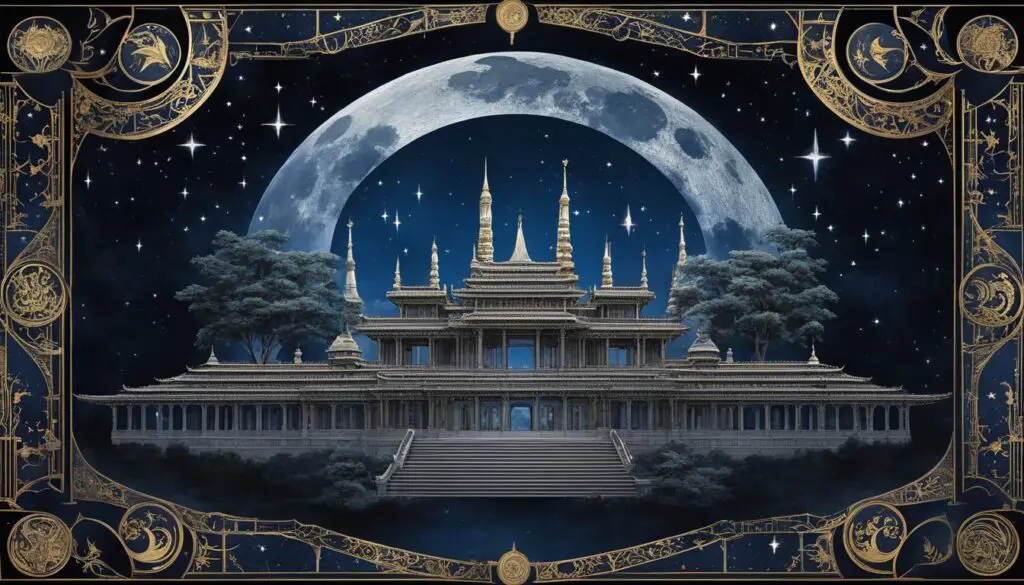
Selene, the Greek goddess of the moon, is part of an illustrious Titan family in Greek mythology. She is the daughter of the Titans Hyperion and Theia, and her divine lineage adds to the richness of her role as the moon goddess. Selene’s siblings include Helios, the sun god, known for his radiant chariot that traverses the sky, and Eos, the goddess of the dawn, who brings forth the new day with her vibrant colors.
Hyperion, Selene’s father, represents light and wisdom, while Theia, her mother, embodies the splendor and brilliance of the divine. Together, their offspring symbolize the celestial forces that govern the cosmos in Greek mythology.
The intricate family ties of Selene emphasize her connection to different aspects of the natural world. While Helios illuminates the day with his radiant presence, Selene lights up the night sky with her gentle glow. Eos, on the other hand, heralds the dawn, marking the transition from darkness to light. The interplay between the three siblings reflects the cycle of time, emphasizing the significance of each stage in the daily celestial journey.
This harmonious relationship between Selene, Helios, and Eos highlights the unity and interconnectedness of the heavens. Their collective presence and influence in Greek mythology illustrate the enduring power of the Titan family and their profound impact on the mortal realm.
Selene’s Romances and Relationships
Selene, the Greek goddess of the moon, has been entangled in various romantic relationships throughout Greek mythology. These compelling love stories add depth and intrigue to her celestial character.
Zeus and Selene
One of Selene’s renowned lovers is Zeus, the mighty king of the gods. Their union symbolizes the celestial relationship between the moon and the sky. The passionate connection between Selene and Zeus transcends mortal boundaries, reflecting the power and allure of their divine love.
Pan and Selene
Another deity who captured Selene’s heart is Pan, the playful god of shepherds and the wild. The mischievous nature of Pan complements Selene’s ethereal beauty, creating an enchanting and whimsical love story that sparks the imagination.
Endymion and Selene
However, Selene’s most famous and enduring love story is with the mortal shepherd Endymion. Endymion’s eternal sleep, granted by Zeus himself, allows Selene to visit him every night under the moon’s gentle glow. Their forbidden love represents the longing and devotion between mortal and immortal, bringing a touch of bittersweet romance to Greek mythology.
Selene in Greek Art and Representation
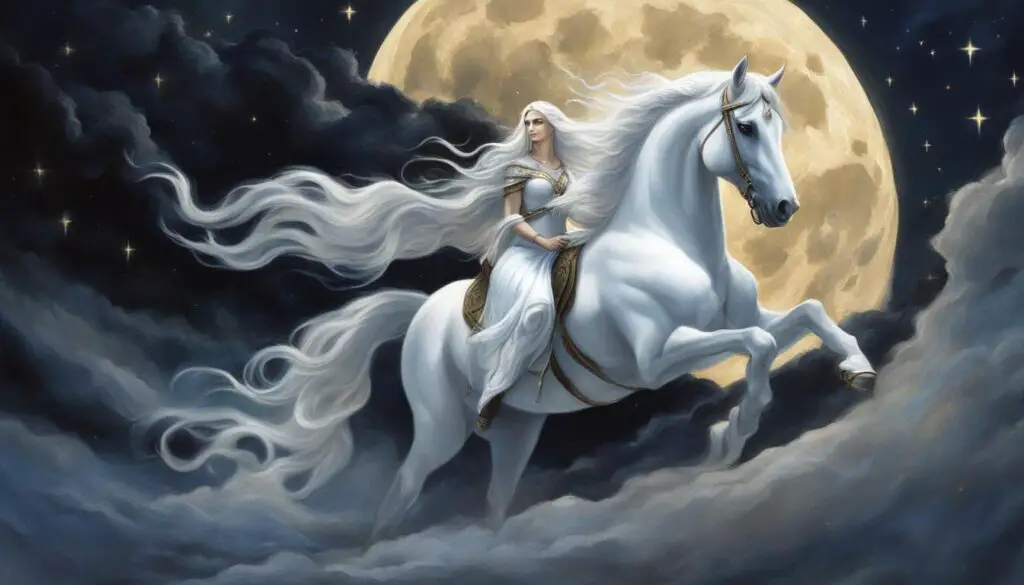
Selene, the Greek goddess of the moon, has been a subject of fascination in Greek art throughout history. Greek artists have skillfully captured her significance and beauty in various forms of artistic representation.
One common depiction of Selene is her riding a horse or driving a chariot pulled by white horses. This imagery emphasizes her ethereal and otherworldly nature, showcasing her divine status as the goddess of the moon. Artists often portray Selene with grace and poise, highlighting her connection to the celestial realm.
Symbolism plays a crucial role in Selene’s artistic representations. The crescent moon is a central symbol associated with her, representing her role in the lunar cycles. Additionally, the crown is often depicted as an emblem of her divinity, signifying her status as a goddess.
The Parthenon, an iconic Greek temple, features a famous sculpture depicting Selene and her horses. This masterpiece exemplifies her importance in Greek mythology and art. It showcases Selene’s connection to the passage of time and the divine forces that govern the celestial bodies.
In Greek art, Selene’s iconography serves as a testament to her enduring influence as the goddess of the moon. Through intricate detail and artistic mastery, these representations bring forth the beauty, power, and significance of Selene in Greek culture.
Selene’s Connections with Other Gods and Figures
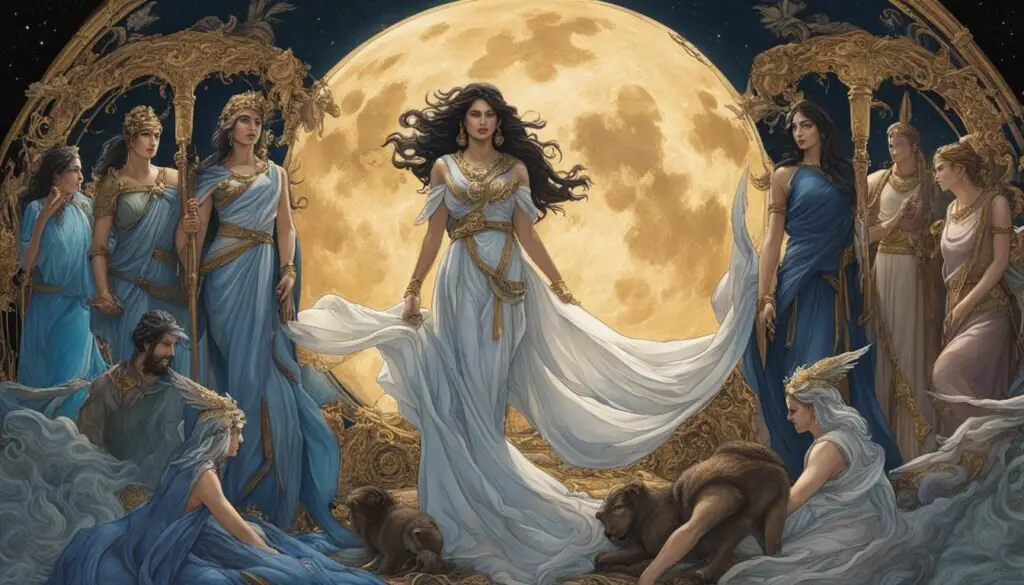
Selene, the Greek goddess of the Moon, has fascinating connections with various gods and figures in Greek mythology. These connections add depth to her character and highlight her importance in the pantheon.
1. Selene and Pan
Selene’s encounters with Pan, the god of shepherds and the wild, resulted in mysterious and enchanting tales. The moon goddess and the mischievous Pan form an intriguing relationship that adds an element of magic to their stories.
2. Selene and Heracles
Selene is also linked with Heracles, one of the greatest heroes in Greek mythology. Their connection adds a heroic dimension to Selene’s character and showcases her involvement in the adventures of mortals.
3. Selene and Creation Myths
In addition to her connections with specific gods and heroes, Selene is associated with the creation of mythical creatures such as the Nemean Lion. These creation myths further solidify Selene’s role as a powerful goddess and a key figure in the mythology of ancient Greece.
These connections with other gods and figures demonstrate Selene’s significance and influence within the pantheon of Greek deities. Her interactions with Pan, Heracles, and involvement in creation myths contribute to her multifaceted nature as the divine embodiment of the Moon.
Worshiping Selene: Rituals and Festivals

Worshiping Selene, the Greek goddess of the moon, involved an array of rituals and festivals deeply rooted in moon-related practices. These reverent ceremonies were specifically conducted during significant lunar phases, such as the Full Moon and New Moon, to honor and celebrate Selene’s divine presence.
Followers of the cult of Selene would gather at sacred places, such as temples or open-air sanctuaries, to engage in moon-watching, lunar offerings, and prayers. These gatherings fostered a sense of community and allowed individuals to connect with the celestial realm.
Selene’s association with magic and sorcery permeated these worship practices. Participants would harness the ethereal energy of the moon, seeking blessings, illumination, and guidance in their lives. Through rituals and invocations, devotees aimed to establish a mystical connection with Selene and tap into her lunar powers.
Moonlit Gatherings
- Moonlit gatherings held during Full Moon nights brought together worshipers seeking Selene’s blessings and guidance.
- Dressed in flowing white garments, participants would come together in sacred spaces, illuminated by the moon’s gentle glow.
- They would engage in rhythmic chants, dancing, and meditation, fostering a deep spiritual connection with Selene.
Lunar Offerings
- Devotees would present lunar offerings, which varied from precious gems and flowers to food and libations.
- Fruits and wines were often offered to symbolize abundance and the cyclic nature of life.
- These offerings served as a gesture of gratitude and reverence towards Selene, strengthening the bond between the mortal and divine realms.
Prayers and Invocations
- Prayers and invocations were an essential part of Selene worship.
- Worshipers would offer personalized prayers to Selene, seeking her divine intervention in matters of the heart, fertility, and protection.
- Invocations would often take place during moonlit nights, as the connection to Selene was believed to be strongest during these times.
Through these rituals and festivals, followers of Selene celebrated her influence on lunar cycles and embraced her as a guiding force in their lives. The worship of Selene exemplified the deep reverence and fascination ancient Greeks held for the moon, its luminosity, and the divine energy it represented.
Exploring the Symbolism of Selene
Selene, the Greek goddess of the moon, is rich in symbolism that reflects her divine nature and connections with other deities. Let’s delve into the captivating symbolism surrounding Selene, including her association with the sky, identification with other gods, and her relationship with Eos, the goddess of dawn.
Selene’s symbolism extends to the celestial forces of the sun and the sky. As the goddess of the moon, her connection with the sky highlights her divine essence and her role in illuminating the night. She represents the ethereal nature of the heavens, embracing the mystique of the celestial realm.
In Roman mythology, Selene is often linked to the goddess Luna, further emphasizing her association with the moon. The identification with Luna underscores her influence and importance as a lunar deity, solidifying her place in ancient mythology beyond the realm of Greece.
One of Selene’s most intriguing symbolisms lies in her relationship with Eos, the goddess of the dawn. The contrast between Selene’s moon and Eos’ dawn creates a harmonious duality where night transitions into day. This relationship adds depth and complexity to Selene’s character, representing the cyclical nature of time and the continuous transition from darkness to light.
Selene Symbolism at a Glance:
- Connection to the sky and the sun
- Identification with other gods, including Luna in Roman mythology
- Relationship with Eos, the goddess of the dawn
Through her symbolism, Selene embodies the profound connection between the cyclical nature of the moon, the celestial realm, and the passage of time. Her association with the sky, identification with other gods, and relationship with Eos showcase the multifaceted nature of this captivating Greek moon goddess.
Selene – Goddess of Agriculture and Fertility
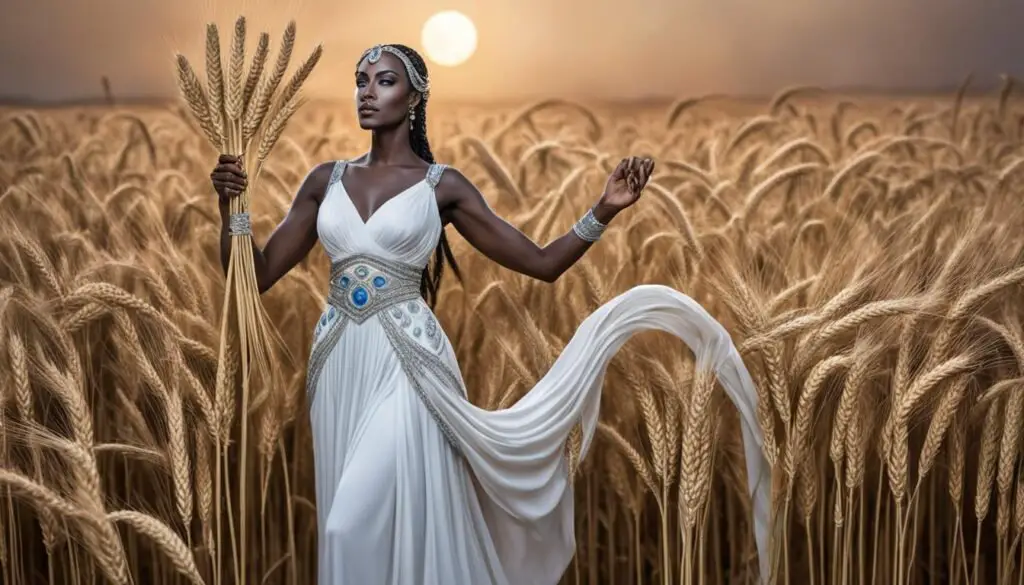
Selene, the revered goddess of the moon, held a multifaceted role in Greek mythology. Apart from her association with the lunar sphere, she was also worshipped as a goddess of agriculture and fertility. As the divine embodiment of the moon, Selene was believed to have a profound influence on nature and the cycles of life.
The presence of Selene in the night sky was considered beneficial to agricultural endeavors. It was believed that her radiant light brought nourishing night dew, which contributed to the growth and fertility of plants. Farmers and cultivators would look to the moon for blessings and abundance, recognizing Selene as the provider of agricultural sustenance.
Selene’s Connection to Seasons
Furthermore, Selene’s connection to the natural phenomena of time and seasons was deeply intertwined with her role as a goddess of agriculture and fertility. As the moon waxed and waned, reflecting the changing lunar cycles, Selene’s influence extended to the rhythms of the earth and its seasons. Her ethereal presence during the dark nights symbolized the rejuvenation of nature, heralding the arrival of spring and the cycles of growth and harvest.
The Importance of Selene’s Influence
The reverence for Selene as a goddess of agriculture and fertility highlights the significance of the moon in ancient agricultural societies. The interplay between Selene’s luminosity, the cycles of nature, and the sustenance of humanity through agriculture was deeply ingrained in Greek mythology and culture.
- Her connection to agriculture emphasized the interconnectedness of the divine, natural, and human realms.
- Her role as a fertility goddess revealed the deep-rooted veneration for the life-giving powers of the moon.
- Her association with seasons showcased the cyclical nature of life and the indispensable rhythm of the changing agricultural calendar.
The multifaceted persona of Selene as the goddess of the moon, agriculture, and fertility served to unite these essential aspects of human existence and highlight their harmonious coexistence within the sacred realms of Greek mythology.
Selene’s Names and Variations
Selene, the Greek goddess of the moon, is known by various names in Greek mythology. Each name emphasizes different aspects of her divine identity and associations.
- Mene: One of Selene’s common names is Mene, which means “the moon” or “the lunar month.” This name highlights her role as the personification of the moon itself.
- Phoebe: In her identification with Artemis, Selene is also referred to as Phoebe. This name portrays her close connection to the goddess of the hunt and wild animals.
- Cynthia: Another name for Selene is Cynthia, which further solidifies her association with Artemis. It symbolizes her link to Mount Cynthus, the birthplace of both Selene and Artemis.
These distinct names showcase the multifaceted nature of Selene’s divine persona and add depth to her character in Greek mythology.
Selene in Various Ancient Cultures
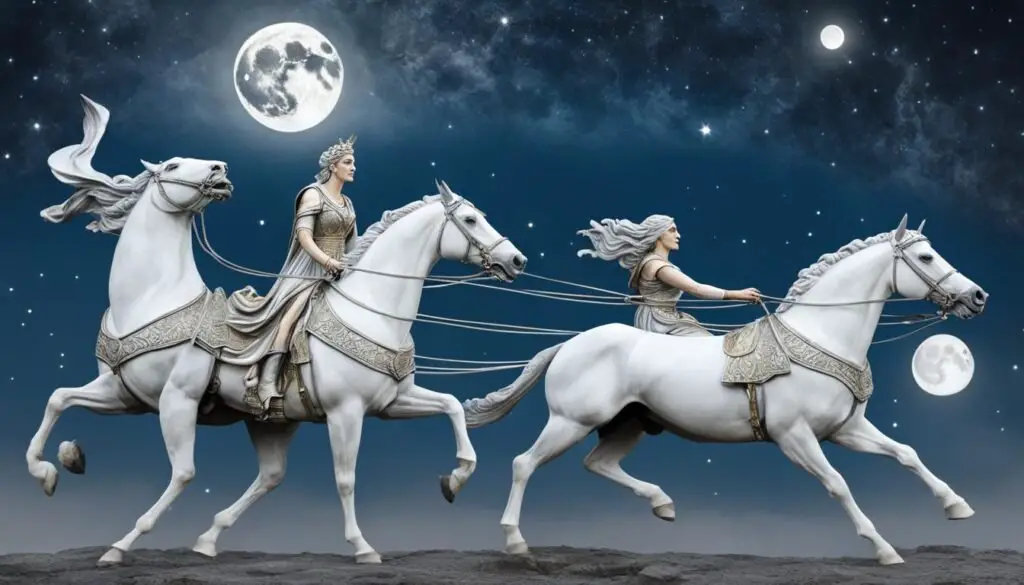
Selene’s divine presence extends beyond Greek mythology. In Roman mythology, she is associated with the goddess Luna, who shares her role as the moon deity. In fact, Luna is often considered the Roman equivalent of Selene.
In addition to Roman mythology, moon gods and goddesses have been revered in other ancient pantheistic cultures as well. In Mesopotamian mythology, the moon god Sin held a prominent place in the celestial hierarchy. He was associated with wisdom, fertility, and time. Similarly, in Egyptian mythology, the god Khonsu was worshipped as the lunar deity, representing the cyclic nature of the moon and its influence on agricultural fertility.
While Selene is not traditionally considered a moon goddess in these cultures, it is worth noting that other deities have associations with or are connected to the moon in different ways. For example, the Egyptian goddess Isis, known for her powerful magic and motherly attributes, symbolized the lunar cycle as she played a crucial role in the resurrection of her husband Osiris. The Greek goddess Nyx, often associated with the night, is also intertwined with the moon due to her dominion over darkness and its association with lunar cycles.
These parallel moon deities across ancient cultures demonstrate the universal fascination and reverence for the celestial body known as the moon.
Conclusion
In Greek mythology, Selene holds a significant position as the goddess of the moon. She is revered for her beauty, power, and connections with other deities and mortals. As the personification of the moon, Selene’s divine presence is reflected in Greek art and religious practices.
Through her symbolism, Selene adds depth to her divine identity. Depicted riding her moon chariot or driving a chariot pulled by white horses, she embodies the ethereal and otherworldly nature of the moon. The crescent moon and crown are symbols associated with Selene, representing her connection to the lunar cycles and her divine status.
With her captivating tales and mysterious allure, Selene stands as a celestial figure deserving of reverence in Greek mythology. Her significance in Greek culture and her role as the moon goddess demonstrate the profound influence she had on ancient Greek society and its understanding of the cosmos.
FAQ
Who is the moon goddess in Greek mythology?
The moon goddess in Greek mythology is Selene, also known as Mene.
What is the role of Selene, the Greek moon goddess?
Selene is revered as the divine embodiment of the moon in Greek mythology, illuminating the night sky and enchanting mortals with her radiance.
Who are Selene’s family and lineage?
Selene is the daughter of the Titans Hyperion and Theia. She has two siblings, the sun god Helios and the dawn goddess Eos.
What are some of Selene’s romantic relationships?
Selene is associated with various romantic partners in Greek mythology, including Zeus, Pan, and the mortal Endymion.
How is Selene depicted in Greek art?
Selene is often portrayed riding a horse or driving a chariot pulled by white horses. She is associated with the crescent moon and is depicted wearing a crown.
Who are some of the gods and figures Selene is connected with?
Selene has connections with gods and figures such as Pan and Heracles in Greek mythology.
What were the rituals and festivals associated with worshiping Selene?
Worshiping Selene involved rituals and festivals conducted during significant lunar phases, such as the Full Moon and New Moon, to honor and celebrate her divine presence.
What does Selene symbolize?
Selene symbolizes her connection to the sky and the sun, as well as her identification with other deities such as Artemis and her relationship with Eos.
What is Selene’s association with agriculture and fertility?
Selene was revered as a deity of agriculture and fertility, with her presence in the night sky believed to bring nourishing dew for plants and restful sleep for humanity.
What are some of the names and variations of Selene in Greek mythology?
Selene is also known as Mene, Phoebe, and Cynthia in Greek mythology.
Is Selene present in other ancient cultures?
While primarily a Greek goddess, Selene’s lunar counterparts exist in other ancient pantheistic cultures, such as the Mesopotamian Sin, the Egyptian god Khonsu, and the Roman Luna.


